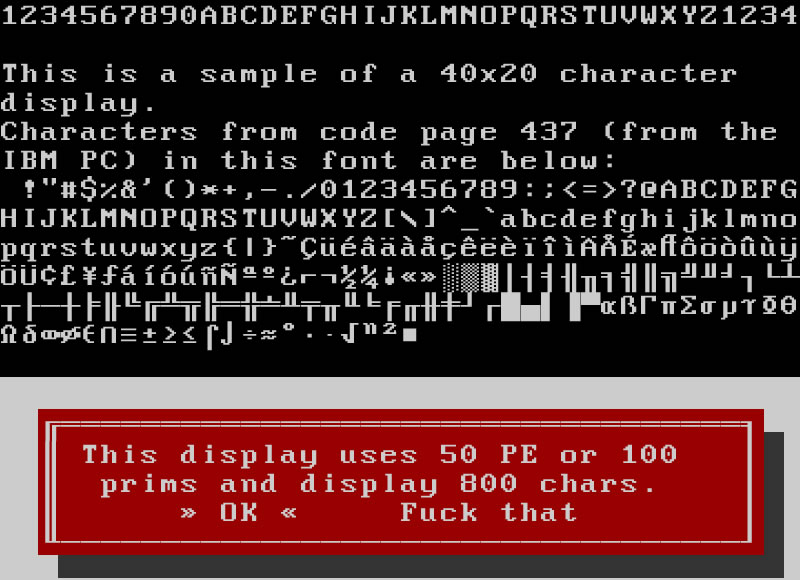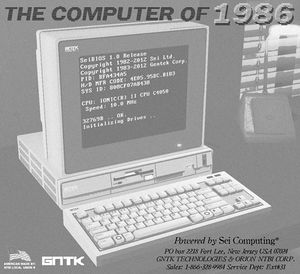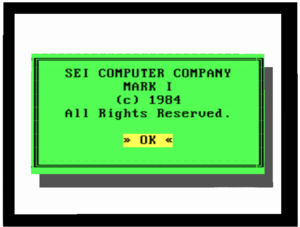Difference between revisions of "Mark 1"
imported>NelsonJenkins |
imported>NelsonJenkins |
||
| Line 7: | Line 7: | ||
The Mark I was first spawned in December 2011 by [[Nelson Jenkins]] with assistance from [[Will Szymborska]]. The idea of an individual-character display was thrown around for years, but wasn't technically feasible until recently due to newer LSL functions and mesh construction possibilities. [[Adel Button]] assisted by designing the character display object, which was scripted in only a few hours late at night. The first design ever displayed on the Mark I display was a green SeiOS dialog box with a drop shadow. The casing and peripherals were made in the following weeks, along with the core of SeiOS. | The Mark I was first spawned in December 2011 by [[Nelson Jenkins]] with assistance from [[Will Szymborska]]. The idea of an individual-character display was thrown around for years, but wasn't technically feasible until recently due to newer LSL functions and mesh construction possibilities. [[Adel Button]] assisted by designing the character display object, which was scripted in only a few hours late at night. The first design ever displayed on the Mark I display was a green SeiOS dialog box with a drop shadow. The casing and peripherals were made in the following weeks, along with the core of SeiOS. | ||
| − | Originally the display was going to be [[File:Mk1-DisplayDesign.png|40x20 characters], which would have been 50 prims land impact. However, the display was sized down to 32x15 characters, which reduced the land impact cost considerably. Moving forward, it was also noted that nearly double the characters also would have made the display's full refresh rate unacceptably slow. | + | Originally the display was going to be [[File:Mk1-DisplayDesign.png|40x20 characters]], which would have been 50 prims land impact. However, the display was sized down to 32x15 characters, which reduced the land impact cost considerably. Moving forward, it was also noted that nearly double the characters also would have made the display's full refresh rate unacceptably slow. |
Revision as of 18:19, 3 August 2013
The Mark I is a computer hardware platform in production by Sei Computing. It features a wide variety of software and realistic, immersive operation.
Origins
The Mark I was first spawned in December 2011 by Nelson Jenkins with assistance from Will Szymborska. The idea of an individual-character display was thrown around for years, but wasn't technically feasible until recently due to newer LSL functions and mesh construction possibilities. Adel Button assisted by designing the character display object, which was scripted in only a few hours late at night. The first design ever displayed on the Mark I display was a green SeiOS dialog box with a drop shadow. The casing and peripherals were made in the following weeks, along with the core of SeiOS.
Originally the display was going to be  , which would have been 50 prims land impact. However, the display was sized down to 32x15 characters, which reduced the land impact cost considerably. Moving forward, it was also noted that nearly double the characters also would have made the display's full refresh rate unacceptably slow.
, which would have been 50 prims land impact. However, the display was sized down to 32x15 characters, which reduced the land impact cost considerably. Moving forward, it was also noted that nearly double the characters also would have made the display's full refresh rate unacceptably slow.
Hardware
The Mark I's hardware is as follows (system calls):
- 480-character 16-color display w/ multi-tile sprite support & 8-layer underlay
- 256-color mode available with high-color display driver available with some programs
- 22 kB hard disk
- 22 kB hot-swappable floppy disk drive
- 10 MHz optimum processor clock rate
- 256 kB of RAM
- Dual 9-pin serial ports (although up to 9 component connections are supported)
- 87-key keyboard with direct (gesture) and indirect (touch) input support
- 10 Mbit/s Ethernet local network card (same-region communications only)
Additionally, add-on components provide the following hardware:
- 60 cps / 60 dpi dot-matrix printer
- Dual 40 kB floppy disk drives + dual 40 kB hard disk "databox" external drive
- 14.4 kbit/s modem compatible with SeiNet Protocols gridwide
The DS/200 Server also provides a 40 kB hard disk and 40 kB floppy disk drive for network use.
Software
There are three types of software supported by the Mark I:
- SeiOS system software
- Provides core functionality of the SeiOS system
- Cannot be modified or removed, except by System Core Upgrade Disk (SCUD)
- Does not take up space on disk
- SeiOS programs
- Installable by the user using a general floppy disk (or pre-installed)
- Direct access to system components and large memory use
- Can only be created by developers enrolled in the Developer Affiliate Program
- Does not take up space on disk
- SeiBASIC programs
- Run directly from hard disk or general floppy disk
- Limited/slower access to system through SeiBASIC functions
- Can be created and distributed by anyone
- Limited memory use
- Takes up space on disk

